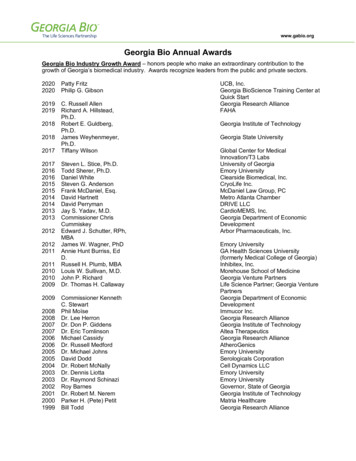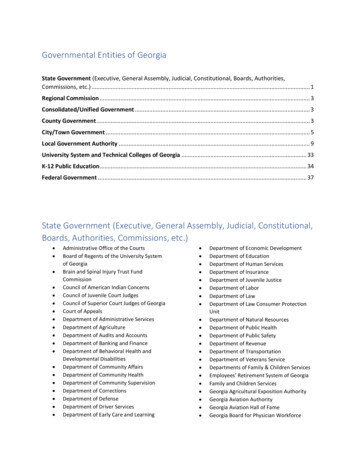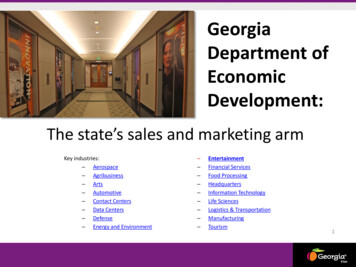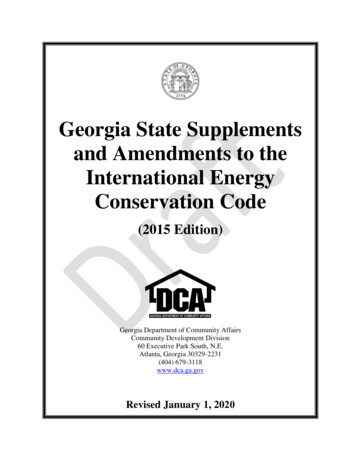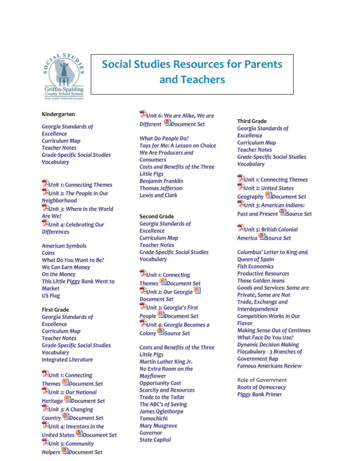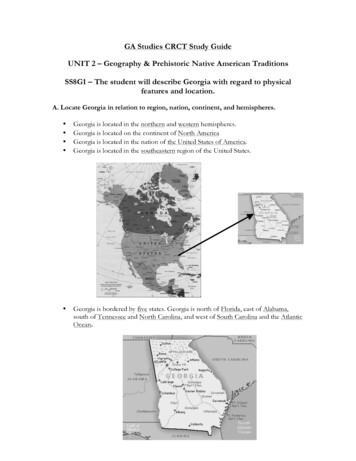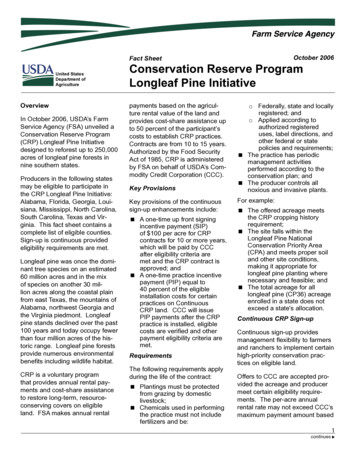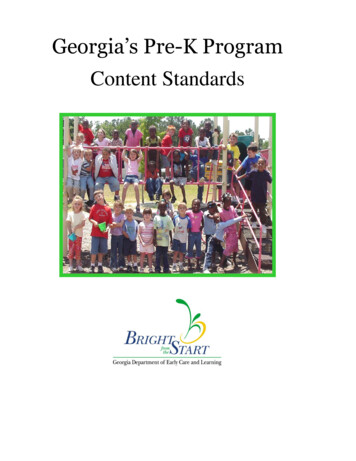
Transcription
Georgia’s Pre-K ProgramContent Standards
CONTENTSIntroductionIntroduction . 4Acknowledgements . 5History of Georgia’s Pre-k . 6School Readiness Definition . 8Kindergarten Readiness .10Kindergarten Transition Activities .11Books for Kindergarten Transition .12Inclusion Overview .13English Language Learners .14Language and Literacy Development (LD)Introduction and Inclusion Techniques .15Listening .16Phonological Awareness .17Vocabulary Development .17Expressive Language .18Reading .19Writing .20Home and Family Connections .21Teacher Resources .22Suggested Children’s Books .23Mathematics Development (MD)Introduction and Inclusion Techniques .24Numbers .25Patterns .26Sorting and Classifying .26Geometry .27Measurement .28Home and Family Connections .30Teacher Resources .31Suggested Children’s Books .32Science Development (SD)Introduction and Inclusion Techniques .33Exploration .34Life Science .34Physical Science .35Earth Science .35Home and Family Connections .36Teacher Resources .37Suggested Children’s Books .382
Social Studies Development (SS)Introduction and Inclusion Techniques .39Families and Community .40Respect for Differences .40Geographical Thinking .41Home and Family Connections .42Teacher Resources .43Suggested Children’s Books .44Creative Development (CD)Introduction and Inclusion Techniques .45Artistic Expression .46Music and Movement .46Drama .47Home and Family Connections .48Teacher Resources .49Suggested Children’s Books .50Social and Emotional Development (SE)Introduction and Inclusion Techniques . 51Self-Awareness . 52Curiosity, Initiative, Self-Direction, Persistence . 53Self-Control . 53Interpersonal and Social Skills . 53Home and Family Connections . 54Teacher Resources . 55Suggested Children’s Books . 56Health and Physical Development (HPD)Introduction and Inclusion Techniques . 57Gross Motor . 58Fine Motor . 58Health and Safety . 58Home and Family Connections . 59Teacher Resources . 60Suggested Children’s Books . 613
INTRODUCTIONWelcome to the 2012-2013 edition of Georgia’s Pre-K Program Content Standards, which provide thefoundation for instruction in all Georgia’s Pre-K classrooms. The Pre-K Content Standards were last revisedin March 2009 and are currently being reviewed again this school year.This edition of the Content Standards includes:Correlations with Kindergarten Common Core Georgia Performance Standards (KCCGPS)*Strategies to support inclusive classrooms“Learning in Action” suggestions for classroom practiceProfessional resources for each curriculum domainLists of high quality children’s literature for each curriculum domainTips to support family involvement in the child’s educationWith the Kindergarten Common Core Georgia Performance Standard (KCCGPS) correlations, it is clear howwhat is taught in Pre-K lays the foundation for expectations in Kindergarten. Each Pre-K Content Standardhas been matched to an appropriate KCCGPS. In some cases a Pre-K Content Standard will match severalKindergarten standards; however, there is not always a corresponding Kindergarten standard for every PreK Content Standard. Keep in mind that the Pre-K Content Standards and the Kindergarten performancestandards reflect what children should know at the end of the Pre-K or end of the Kindergarten year– not at the beginning. Seeing how these standards relate is helpful to Pre-K teachers, Kindergartenteachers and parents – all of whom have a part in making children successful in the early years.The section on strategies to support inclusive classrooms will help individualize instruction to meet theneeds of all of the students in your classroom. The “Learning in Action” section of the Content Standardsprovides examples of appropriate and active activities to build assist in building these skills. Theprofessional resources and children’s literature for each domain will assist in planning quality instruction.Family involvement and support, covered in the Home and Family Connection tips, are important to achild’s academic success, so each learning domain includes ideas for strengthening the connection betweenhome and school.The Content Standards are used for planning instruction, assessing growth and development, and sharinginformation with families. These standards are important for a number of reasons; the most important are:1. Because Pre-K children learn and develop at varying rates, instruction must be planned to meet eachchild’s individual needs; 2. Pre-K children learn best with a balance of teacher-directed and child-initiatedactivities that encourage thinking, reasoning and communication; 3. Pre-K children need movement, handson activities, lots of language, and a supportive environment.National research shows that Pre-K programs with effective teaching practices and a challenging andappropriate curriculum enhance children’s intellectual, physical, and emotional development. Bright fromthe Start hopes that these standards will help Pre-K programs exceed expectations in all program areas. Forquestions concerning these standards, contact Bright from the Start (404) 656-5957, your Pre-K Consultant,or visit the Bright from the Start website at www.decal.ga.gov.* The Kindergarten Common Core Georgia Performance Standards for English Language Arts and Mathwere approved by the Georgia Department of Education in 2011. In Kindergarten the domains of Science,Social Studies, Health and Physical Development, Social and Emotional Development and CreativeExpression are covered under the Georgia Kindergarten Performance Standards or the Georgia Quality CoreCurriculum Standards. For more information on the Kindergarten Common Core Georgia PerformanceStandards visit the Georgia Department of Education website at www.doe.k12.ga.us.4
Georgia’s Pre-K ProgramGeorgia's Pre-K Program was established in 1993 through the Georgia Lottery for Education to provideGeorgia's four-year-old children with high-quality preschool experiences. The goal of every Georgia’s Pre-Kclassroom is to provide Pre-K students with the learning experiences they need to prepare for Kindergarten.History of Georgia’s Pre-K ProgramThe Pre-K Program began as a pilot program serving 750 at-risk four-year-old children and their families at 20sites in 1992. The first lottery funds were utilized in 1993-94 to provide prekindergarten programs for more than8,700 at-risk four-year-old children. In September 1995 the program was opened to all eligible four-year-oldchildren, not just at-risk families. The program tripled its enrollment from 15,500 children in 1994-95 to 44,000slots during the 1995-1996 school year. During this time the private sector became an integral part of theprogram, allowing the program to expand quickly without utilizing funds for capital outlay on new buildings orexpansion facilities. A public/private partnership of this magnitude was a first in Georgia and the nation.Enrollment in Georgia’s Pre-K program has continued to expand yearly with 84,000 students currently beingserved this year. Over one million students have participated in Georgia’s Pre-K program since 1993. This yearwill mark the 20th year of serving children in Georgia’s Pre-K Programs across the state.Pre-K Program ComponentsA national survey of public Kindergarten teachers noted three primary essentials for school readiness: childrenare physically healthy, rested, and well nourished; they are able to communicate needs, wants, and thoughtsverbally; and they are enthusiastic and curious in approaching new activities. Georgia'sPre-K Program provides children with experiences that foster all these essentials.An appropriate program for four-year-olds is not a watered down Kindergarten program. Children learnthrough play and learning centers, which are integral parts of Pre-K classrooms. Pre-K programs reflect anunderstanding of how children learn by emphasizing active learning, consistent daily routines, and the use ofpositive behavioral management and assessment strategies. The school readiness goals of thePre-K program provide appropriate preschool experiences emphasizing growth in language and literacy, mathconcepts, science, social studies, arts, health and physical development, and social and emotional competence.Health ServicesTo ensure a healthy start, all children enrolled in the Pre-K program must have hearing, vision, and dentalexamination certificates on file within 90 days of starting the Pre-K program. Also, evidence of age-appropriateimmunizations must be on file within 30 days of the start of the Pre-K program. At the end of the school year,parents are provided with comprehensive information on all health and entrance documentation necessary forsuccessful entry into Kindergarten.Parents as First TeachersParents are encouraged to volunteer in the Pre-K classroom and to participate in meetings, parent groupactivities, or workshops. At least two individual conferences per year between the lead teacher and family mustbe offered by providers and documented in each child's on-site file.The Pre-K program strongly encourages parents to read to their children on a daily basis. To foster this habit atthe beginning of each school year, children in the program are provided with a special edition of a book selectedby and including a personalized message from the Governor of Georgia.Quality OutcomesResearch continues to substantiate the positive impact that high quality preschool programs have on youngchildren. A recent evaluation of a similar program in Oklahoma demonstrated that participation in a highquality program can be a stronger predictor of a child’s pre-reading and pre-math skills than certain familycharacteristics. A similar evaluation of Georgia’s Pre-K Program conducted from 2001-2004 by GeorgiaState University found that children who attended Georgia’s Pre-K had larger gains than their same-agedpeers who did not attend the program. Furthermore, they were rated higher in academic and social skillratings by their Kindergarten teachers than other children.5
―Play is often talked about as if it were a relieffrom serious learning. But for children, play isserious learning. Play is really the work ofchildhood.‖Fred Rogers6
School Readiness DefinitionThe first of the National Education Goals states “all children will start school ready to learn.” Georgia hasformulated its definition of school readiness within the context of the nature of four-year-olds and how theylearn. We believe school readiness must be defined within the context of families and how they live. It must bedefined within the context of communities and the services they provide. And, it must be defined within thecontext of schools and their readiness for children.A child’s readiness for school is when . . .possible health barriers that block learning have been detected,suspected physical or mental disabilities have been addressed,enthusiasm, curiosity, and persistence toward learning is demonstrated,feelings of both self and others are recognized,social and interpersonal skills are emerging,communication with others is effective,early literacy skills are evident, anda general knowledge about the world, things, places, events, and people has been acquired.Indicators for each dimension of school readiness include but are not limited to the following:. . . possible health barriers that block learning have been detectedEye, ear, and dental screenings will detect problems related to seeing, hearing, and dental health.Immunizations will be on schedule.Diseases and other health issues will be detected as early as possible.Rate of growth and mobility within acceptable ranges will be determined. . . suspected physical or mental disabilities have been addressedSuspected physical and mental disabilities will be detected and referrals will be made as early aspossible. . . enthusiasm, curiosity, and persistence toward learning is demonstratedAttitudes toward and interest in learning will demonstrate a readiness to learn.Persistence in completing tasks will be evident. . . feelings of both self and others are recognizedFeelings will be identified and expressed appropriately.Feelings of others will be understood and accepted.An increasing capacity for self-control will be evident. . . social and interpersonal skills are emergingAbility to work or play cooperatively with others will be evident.Ability to form appropriate relationships with children and adults will be demonstrated.Emerging conflict resolution skills will be evident.Increasing capacity to follow rules and routines will be evident. . . communication with others is effectiveListening skills will be evident.Ability to follow simple directions will be evident.Expressing needs and wants will be demonstrated.Use of language to interact socially with others will be demonstrated.Ability to describe people, places, things, and events will be evident.Ability to ask and answer age-appropriate questions will be demonstrated . . . early literacy skills are evidentAssociation between spoken and written words will be recognized.Understanding of beginning alphabetic knowledge will be demonstrated.Ability to discriminate sounds will be evident.Knowledge of basic book and story components will be evident.Use of shapes and marks to convey meaning will be demonstrated.Writing letters to represent word and syllables will be demonstrated7
. . . a general knowledge about the world, things, places, events, and people hasbeen acquiredRecognition of name will be evident.Basic awareness of self, family, and community will be demonstrated.Knowledge of simple science concepts will be evident.Knowledge of simple math concepts will be evident.Ability to count up to 10 will be evident.Basic understanding of shapes and colors will be demonstrated.Ability to sort and classify objects will be evident.8
Getting a Bright Start to KindergartenStrengthening the Transition from Pre-K to KindergartenProviding for a smooth transition from Pre-K to Kindergarten is a critical part of Georgia’s Pre-Kprogram. When looking at Kindergarten transition, it is important to remember that it is a yearlong process, not something that happens in April or May of the school year. Transition planningoccurs at several levels and involves building relationships, aligning curriculum, and sharinginformation. Based on research, the Regional Educational Laboratory key components ofsuccessful transition planning include:Connecting Children to ChildrenPlan activities to strengthen the relationships between Pre-K and Kindergarten students. This caninvolve a visit to a Kindergarten class, inviting a Kindergarten student to visitPre-K, video a Kindergarten student reading and show to your class, having a “reading buddy”from another grade level, or making a picture book or video about students in Kindergarten.Connecting Children to SchoolsBegin practicing Kindergarten routines in the spring to familiarize Pre-K children withKindergarten. This can involve adding cafeteria trays to the dramatic play area so students canpractice walking while holding a tray, learning songs, or reading books about Kindergarten. Havestudents write a letter to the Kindergarten teacher telling about themselves and what they havelearned in Pre-K.Connecting Families to SchoolsShare school events and activities with families and provide information to families concerningschool organizations such as Parent Teacher Association or Parent Teacher Organization. Providefamilies with information on Kindergarten registration and required documentation. Inviteparents on a visit or field trip to the local school.Connecting Schools to SchoolsStrengthening relationships between your school and the receiving Kindergarten schools willsmooth the transition for children and families. This can involve joint workshops between Pre-Kand Kindergarten staff, sharing of information between Pre-K and Kindergarten, or holdingKindergarten registration at the Pre-K site. The alignment of the Pre-K Content Standards withthe Kindergarten Georgia Performance Standards provides for a smoother transition between theinstructional programs.Connecting Community to SchoolsCollaboration between community resources and instructional programs assist families inaccessing services needed for the transition. These relationships can be strengthened throughhosting resource or health fairs to provide screenings for the students and resources for thefamilies.Through planning processes and activities to strengthen these relationships, students andfamilies will arrive at school feeling comfortable and ready to be involved in the educationalprocess. Additional transition ideas are included in this document or visit the Bright from theStart website at www.decal.ga.gov or SERVE’s website at www.terrifictransitions.org. You canalso visit the Department of Education website at www.doe.k12.ga.us for a KindergartenTransition Tool Kit.9
Kindergarten Readiness Ideas to PracticeThroughout the Pre-K Year Practice the morning routines such as a “moment of silence” or pledge to the flag Have the children practice raising hands to answer questions Practice carrying items on cafeteria trays (or cookie sheets) - this can be done in centersas well as during meals and snacks or on the playground Learn to open individual milk cartons and straws Learn to open individual condiment (ketchup, mustard, etc.) packets Practice walking as a group from the classroom to other locations in the building Have the children go to another classroom so another teacher can "teach" them a briefspecial lesson (such as music or P.E). This helps the children get used to the idea thatthey may have other teachers for "specials" Answer "roll call" Practice getting on and off a school bus Practice checking out library books (using a card) from the public library, classroomlibrary, or site office Read aloud children’s books that are about Kindergarten Learn to sharpen a pencil Plan activities that require cooperative interaction. Some ideas are:o Work with a friend to put together teacher made puzzleso Work with a friend to match simple word cards with symbol cardso Work with a friend to match classmates’ name with their pictureo Paint with a partnero Build with a buddyo Group or partner playground gamesRemember that these ideas are to familiarize the children with new concepts and/or routines, so we want to makethem fun! Be sure to have many discussions (large group, small group, and individual) about why youare doing these things.10
Suggested Books for Kindergarten ReadinessAnnabelle Swift, Kindergartner by Amy SchwartzBoomer Goes To School by Constance W. McGeorgeCountdown to Kindergarten by Alison McGheeCurious George Goes to School by Margret ReyDavid Goes To School by Shannon DElizabeti's School by Stephanie Stuve-BodeenFirst Day by Dandi Daley Mackall and Tiphanie BeekeFirst Day Jitters by Julie DannebergFirst Day, Hooray! by Nancy PoydarFranklin Goes To School by Paulette BourgeoisFroggy Goes To School by Jonathan LondonI Want to Go to School Too: A Story about Kindergarten by Liza AlexanderIf You Take a Mouse to School by Laura NumeroffLittle Cliff's First Day of School by Clifton L. TaulbertLook Out Kindergarten Here I Come by Nancy L. CarlsonMiss Bindergarten Gets Ready for Kindergarten by Joseph SlateMouse's First Day of School by Lauren ThompsonMy First Day of School by Patrick K. HallinanMy Teacher Sleeps in School by Leatie WeissSam and Gram and the First Day of School by Dianne L. Blomberg PhD, et alSam Starts School by Barbara Taylor CorkThe Kissing Hand by Audrey Penn, et alThe Night Before Kindergarten by Natasha WingTom Goes to Kindergarten by Margaret WildTwelve Days of Kindergarten by Deborah Lee RoseWelcome to Kindergarten by Anne F. RockwellWhen You Go to Kindergarten by James HoweWho Is Going to School Today? by Karl RuhmannWill I Have a Friend? by Miriam Cohen11
Inclusive Learning Environments in Pre-KInclusion of children with special needs fosters caring attitudes and teaches children aboutacceptance of differences in each other. In high quality early childhood programs, inclusion issimply an example of best practice in meeting the individual needs of each child and their family.Under the Individuals with Disabilities Education Act (IDEA), to the maximum extent appropriate, children with disabilities in public or privateinstitutions or other care facilities in Georgia shall be educated with students who are notdisabled and shall attend the school they would ordinarily attend in their home area orneighborhood, with their age and grade peers in the general education classroom One of the ways to assist children with disabilities in the regular education environment is toprovide accommodations and adaptations based on the needs of each child. Georgia Pre-Kteachers can easily incorporate simple adaptations into their daily routine to create an inclusiveenvironment. Some examples are:Adjust the accessibility of materials to meet the needs of individual children.Define physical boundaries within activities (sitting on a carpet square during circle time)Rearrange the classroom set up to meet the needs of a child.Use adaptive equipment (Big Mac Switches, touch screen for the computer, Alpha Talkersfor communication).Shorten circle time or allow child with attention issues to get up when needed.A list with ideas to create an inclusive environment is included within each domain in the ContentStandards. Suggestions are provided on how to adapt the domain to include children of varyingability levels. Children with diagnosed disabilities may have an Individual Education Program(IEP) through the local school system. Teachers should always consult Special Educationpersonnel regarding specific adaptations and goals for children who have an IEP.For more resources on inclusion, specific disabilities, adaptive equipment, and IDEA visit theDECAL website at www.decal.ga.gov and click on Special Needs under Families or theDepartment of Education/Division of Exceptional Students at www.doe.k12.ga.us and click onSpecial Education.12
Strategies to Support English Language LearnersThe number of children entering Georgia’s Pre-K Program speaking a language other than Englishincreases each year. Georgia is currently the seventh most diverse state in the nation. A language-richPre-K classroom with a supportive teacher is an ideal place for children to become competent in English.Children learning a new language progress through four developmental levels; using the home language,entering into a non-verbal stage, using individual words or short sentences, and using productivelanguage (Tabors). By providing individualized instruction, students gain skills in listening,understanding, and speaking English, which provides for a smoother transition to the program.Environmental and Instructional Supports for English Language LearnersProvide a language rich and emotionally supportive classroom that allows children manyopportunities to hear and understand languageUse repetition to allow children more than one opportunity to understand what is beingsaidEmphasize words as they are spokenExtend children’s language by adding more informationReinforce oral discussions with visual clues or gesturesProvide a running commentary during activitiesLearn some phrases of the child’s home language to use when greeting or during activitiesSit with children during meals/snacks and facilitate natural conversationsConnect new concepts with familiar experiences, objects and knowledgeProvide a quiet place in the classroom where children can use manipulatives, puzzles orplay doughDisplay pictures of the children and familiesTake field trips to locations recommended by English Language Learner’s familyMaintain established routines and daily schedulesProvide organized small-group activities that include the English Language LearnerIntegrate cultural perspectives into everyday learning objectives, not as stand-alonecurriculumProvide an English-speaking buddy or partner for the English Language LearnerProvide multicultural literature, pictures, music, and props in the classroomProvide labels that reflect the languages of the children in the classroomAdd props to the dramatic play area that represent the home languages of the studentsWorking with FamiliesInvite families to visit the classroom and teach songs in the home language, demonstratethe national dress or read a book in the home languageInclude families in assisting with classroom routinesEncourage families to continue to use the native language at homeUse community resource personnel or bilingual parents to assist in translating duringmeetings with non-English speaking familiesTeachers reinforce language development by observing children and by creating environmentsthat set the stage for language use. Classrooms that support English Language Learners have anappropriate language-rich curriculum that includes parental involvement, supports the emotionaldevelopment of children, and incorporates multicultural understanding.ResourcesOne Child, Two Languages. A Guide for Preschool Educators of Children Learning English as aSecond Language, Patton TaborsPromising Practices for Improving the School Readiness of English Language Learners, Readyat FivePreschool Second Language Acquisition: What We Know and How We Can EffectivelyCommunicate with Young Second Language Learners, Janet Quiñones-EatmanResponding to Linguistic and Cultural Diversity: Recommendations for Effective EarlyChildhood Education, NAEYC13
LANGUAGEPre-K children develop language and literacy through interactions with adultsand other children, engagement with materials, and instructional experiences. Inproviding the foundation for later reading, Pre-K children should be exposed toactivities that will develop the ability to listen for comprehension and todiscriminate sounds in language. Children develop an awareness of print andbooks through a variety of activiti
Georgia’s Pre-K Program Georgia's Pre-K Program was established in 1993 through the Georgia Lottery for Education to provide Georgia's four-year-old children with high-quality preschool experiences. The goal of every Georgia’s Pre-K classroom is to provide Pre-K students with the le
